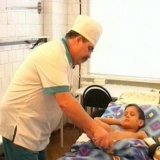Features of the course of infectious diseases in newborns

During pregnancy, with blood flow, each baby is given antibodies from the mother. That is, the child already initially at birth has some immunity, which in the future will help him survive.
In the features of the course of infectious diseases, children are invested with such a notion as AFO( anatomical and physiological features).You understand, that newborns have insufficiently developed organs and systems of organs, accordingly these antibodies are simply necessary for them. Symptoms of infectious diseases in infants as well as in adults, but the incubation period, the prodromal period and the height of the swell last much faster and become much more dangerous. Some diseases can not be detected in newborns, since every newborn has physiological conditions that occur and change within two weeks. For example, physiological jaundice of newborns, that is, yellowing of the eye sclera, icterism of the skin and mucous membranes of the mouth. This state passes independently, because of the peculiar formation of the liver. Talking about any clinical features is almost impossible, because the inspection symptomatology is the same and heavily differentiated. In all newborns, this begins with screaming, anxiety. You understand that such symptoms can not be a clinic, since all newborns behave so constantly.
Symptomatic and peculiarities of leaks FROM
The most "popular" way of transmission of infections in newborns is transplacental, that is, a transmitting infant during childbirth from the mother through the placenta. For such diseases it is easy to follow and find them, as it is enough to pay attention to the woman in childbirth. As already mentioned earlier, any infectious diseases in newborns occur, as well as in adults, although some symptoms may be absent. For example, hepatitis: a child and so at birth, the liver is enlarged and there is jaundice, so it is very difficult to differentiate. Or meningitis, in which there are a number of specific symptoms. This is the rigidity of the occipital muscles, the inability to bend the legs in the knee and pelvic joint. For respiratory infections, there may be tachypnea, sneezing, coughing, lagging of the chest or abdominal muscles in the act of breathing. But again, one can not think that if frequent breathing or sneezing, then immediately ARVI.Here doctors should pay attention to anatomical and physiological features in newborns. Some infectious diseases may not be at all in newborns. For example, a newborn is clearly not sick with tonsillitis, since he has not yet formed tonsils and infections simply have nowhere to localize. But nevertheless, the most frequent infections in newborns are VBI( inside hospital infections).Such infections are a consequence of the lack of compliance with rules and regulations, both personal hygiene of medical personnel, and hospital-acquired hygiene. It manifests a pain in the abdomen, an ambiguous frequent stool, vomiting. The main cause is staphylococcus, fortunately it can be overcome very easily and quickly. Intestinal infections in newborns are almost impossible, as most babies are breastfeeding. Basically, after all, it is transplacentral and intrahospital infections. It's worth paying attention to the mother. Depending on her symptoms and blood test, both the baby and the mom, doctors will quickly find out what it is and will treat them. Also, the appearance of an infection depends on whether the mother is breastfeeding or not. With milk, the mother's antibodies are transmitted, which respectively are transmitted to the baby, which means that it is very difficult for him to get sick than either. Since the kid is unable to indicate the localization of pain and describe its nature, it is impossible to single out any specific differences in clinics from the clinic of adults. The main differences in the course of infectious diseases in newborns is a very short period of the incubation period, a prodromal and rapid development of the peak period. That is, the disease develops very quickly, and the period of the disease itself quickly begins. Before giving birth, the mother must necessarily undergo a complete examination, including all tests.



